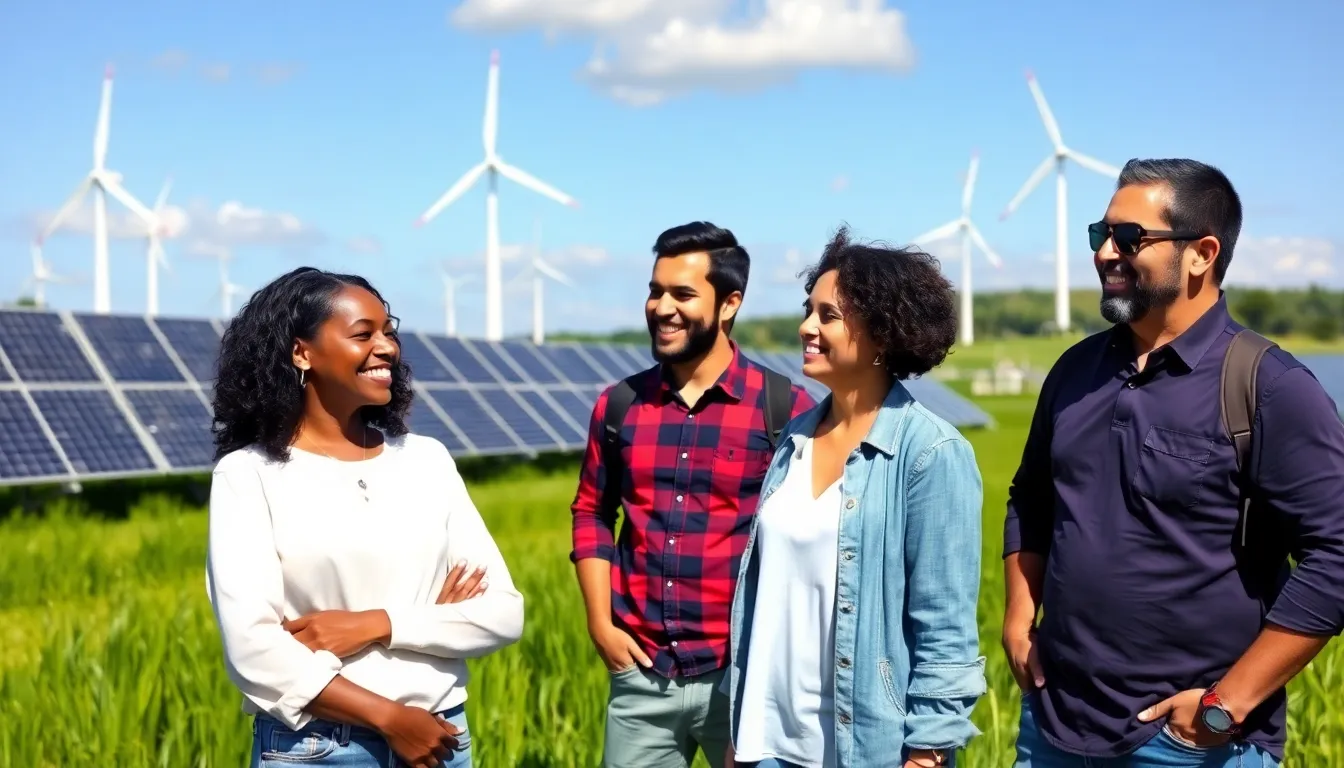In a world where gadgets seem to multiply faster than rabbits, sustainable technology is the superhero we didn’t know we needed. It’s like having your cake and eating it too—only this cake is made from recycled materials and powered by renewable energy. Sustainable tech is all about innovations that not only make life easier but also help save the planet.
Imagine a future where your smartphone doesn’t just connect you to friends but also contributes to a cleaner environment. From solar panels that soak up the sun to electric cars that zoom without leaving a carbon footprint, sustainable technology is reshaping how we live, work, and play. It’s time to embrace these eco-friendly advancements and give Mother Earth a high-five. After all, who wouldn’t want to be both tech-savvy and planet-friendly?
Table of Contents
ToggleUnderstanding Sustainable Technology
Sustainable technology focuses on creating solutions that benefit the environment while supporting societal needs. This concept emphasizes long-term ecological balance through innovation.
Definition of Sustainable Technology
Sustainable technology encompasses tools and systems designed to minimize environmental impact. These inventions often utilize renewable resources and reduce waste. Examples include solar panels, wind turbines, and energy-efficient appliances. It’s crucial that these technologies promote sustainable practices and reduce carbon footprints. Research shows that adopting such technologies can significantly enhance resilience to climate change.
Importance of Sustainability in Technology
Sustainability in technology plays a pivotal role in addressing pressing environmental challenges. Innovations foster cleaner production methods and resource conservation. The global shift towards sustainable technology helps reduce reliance on fossil fuels. Implementing eco-friendly solutions not only drives economic growth but also promotes social responsibility. Major companies increasingly adopt sustainable practices to meet consumer demand and regulatory standards.
Types of Sustainable Technology

Sustainable technology encompasses various innovative solutions aimed at conserving resources and minimizing environmental impact. Different categories highlight unique approaches to achieving sustainability.
Renewable Energy Technologies
Solar panels harness sunlight to produce electricity, promoting clean energy use. Wind turbines convert wind energy into power, offering a renewable alternative to fossil fuels. Hydropower plants utilize flowing water to generate electricity, enabling energy production without air pollution. Geothermal systems tap into the Earth’s heat to provide energy and heating, supporting a low-carbon energy transition. Each technology contributes significantly to reducing greenhouse gas emissions while bolstering energy resilience.
Sustainable Agriculture Technologies
Precision farming employs data analytics to optimize crop yields, reducing resource consumption. Vertical farming utilizes innovative growing techniques to maximize space and minimize water use. Integrated pest management focuses on eco-friendly methods to control pests, reducing reliance on harmful chemicals. Organic farming practices prioritize natural fertilizers and sustainable methods, enhancing soil health. These technologies support efficient food production while addressing environmental concerns.
Waste Management Innovations
Recycling advancements streamline material recovery, ensuring valuable resources are reused. Waste-to-energy technologies convert trash into usable energy, reducing landfill dependence. Composting initiatives transform organic waste into nutrient-rich soil, promoting waste reduction and soil health. Biodegradable materials offer alternatives to conventional plastics, easing pollution issues. These innovations facilitate better waste management practices, encouraging a circular economy.
Benefits of Sustainable Technology
Sustainable technology provides numerous advantages that contribute to a healthier planet and society. Key benefits include environmental impact, economic advantages, and social benefits.
Environmental Impact
Sustainable technology significantly reduces greenhouse gas emissions. Solar panels generate clean energy, while wind turbines exploit natural wind currents. Using these technologies leads to decreased reliance on fossil fuels. Innovations in sustainable agriculture enhance resource efficiency, preserving water and soil. Waste management improvements, such as recycling and composting, minimize landfill waste. Implementing these practices fosters a lower ecological footprint and supports long-term environmental health.
Economic Advantages
Investments in sustainable technology boost economic growth. Renewable energy sources create jobs in manufacturing and installation sectors, supporting local economies. Lower energy bills result from utilizing solar panels and wind turbines, providing financial relief for households and businesses. Companies adopting eco-friendly practices often experience enhanced brand loyalty and customer retention. Cost savings stem from improved efficiency in agriculture and waste management, maximizing productivity while reducing operational costs.
Social Benefits
Sustainable technology fosters healthier communities. Access to clean energy promotes air quality improvements, lowering health risks associated with pollution. Enhanced food production methods ensure food security, supporting local farmers and communities. Waste management innovations encourage community involvement and raise awareness about environmental stewardship. Moreover, education around sustainable practices empowers individuals, fostering a culture of responsibility and commitment to future generations.
Challenges in Implementing Sustainable Technology
Sustainable technology faces several implementation challenges that can hinder its widespread adoption. Addressing these challenges is crucial for achieving long-term ecological goals.
Financial Barriers
Financial constraints often limit advancements in sustainable technology. High initial investment costs discourage businesses from integrating eco-friendly solutions. Many companies struggle to secure funding for projects that do not promise immediate returns. Moreover, insufficient incentives from government agencies can compound these financial difficulties. Businesses wary of potential financial risks may delay or abandon sustainable initiatives altogether.
Technological Limitations
Technological limitations create significant hurdles for the adoption of sustainable technology. Existing infrastructure may not support new, eco-friendly innovations. Compatibility issues arise when integrating renewable energy technologies into outdated systems. Additionally, some technologies still require research and development to enhance efficiency and effectiveness. These limitations often result in slow progress and uncertainty in implementing sustainable solutions.
Future Trends in Sustainable Technology
New trends in sustainable technology promise to enhance the environmental impact of innovations. The focus increasingly centers on developing solutions that are both efficient and eco-friendly.
Emerging Innovations
Advanced renewable energy solutions are on the rise, with breakthroughs in solar panel efficiency and wind energy capture. Smart grids and energy storage systems play crucial roles in optimizing resource use. Additionally, innovations in electric vehicle technology continually improve battery performance and expand charging networks. There’s also a noticeable shift toward bioengineering, which enhances crop resilience while using fewer resources. These advancements address environmental challenges directly and encourage greater accessibility to sustainable solutions.
Global Collaborations
International partnerships are crucial for advancing sustainable technology integration. Collaborative efforts among governments, NGOs, and private sectors drive the sharing of knowledge and resources. Companies align their goals with sustainability targets to meet global climate commitments. Joint ventures in renewable energy projects can attract investment and accelerate deployment in developing regions. Initiatives like the Paris Agreement underscore the need for unified efforts in tackling climate change through technology innovation. Global collaborations create opportunities for diverse perspectives, leading to impactful solutions for sustainability challenges.
Sustainable technology stands at the forefront of addressing environmental challenges while fostering economic growth. Its integration into daily life not only enhances efficiency but also promotes a healthier planet. As innovations continue to evolve there’s a growing recognition of the need for collaborative efforts among various sectors. Overcoming obstacles like financial constraints and outdated infrastructure will be crucial for widespread adoption.
Embracing sustainable practices isn’t just beneficial for the environment; it’s essential for building resilient communities. The future of technology lies in its ability to harmonize with nature and support societal needs. By prioritizing sustainable solutions individuals and businesses can contribute to a more sustainable world for generations to come.

